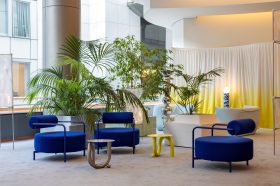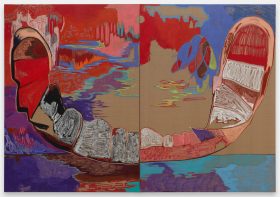After graduating as a painting major, Melita Tickle found her way into a career as Head of Scenic Art for Opera Australia (OA), a position she has now held for a number of years.
Most recently she has been working on the productions Cinderella and Guys & Dolls on Sydney Harbour, ahead of the summer season. And when she is not painting sets for the opera, she continues her own practice as an artist.
ArtsHub catches up with Tickle to better understand this lesser-known career path.
Jump to:
How would you describe what you do to a non-arts friend?
Scenic artists paint all the floors, walls and extra-large props for stage sets. We use many types of paints and texture finishes to transform bare materials into magical scenes. From plain old plywood, we can create anything from an Egyptian sandstone temple to expansive marble Italian villas. One of my favourite things to work on is painting show cloths – they are epic. Show cloths can fill the stage, whether it be a vision of Monet’s waterlily garden or a Parisian opera house auditorium. It is the magic of theatre.
It’s a creative job and often very interesting and engaging. No job is the same as the last; each show design is unique. We work out how to approach each job anew… What are the best materials to use and what technique? What to do first! And, importantly, do it all within the budget!
As the supervisor of the department, I am coordinating and organising the team to get each job done – communicating with production managers and designers. I also spend lots of time doing less creative things like working on budgets, ordering stock and meetings, meetings, meetings!
What qualifications do you need for this job?
Most people who work in the theatre industry as scenic artists have a creative arts qualification of some type, usually a degree from an art school or university. I went to the National Art School (NAS) and majored in painting. Lots of people I work with have been through NAS, NIDA (National Institute of Dramatic Art), VCA (Victorian College of Art), RMIT (Royal Melbourne Institute of Technology), WAAPA (Western Australian Academy of Performing Arts) or the equivalent. That said, you do not need a formal qualification and just having a passion and skill for the job can work. It just may be harder to get your foot in the door is all.
How did you get your start in this career?
After finishing art school I travelled, spent time in Europe on scholarships and generally had a great time. On arriving back in Australia I wanted to settle down some more and I happened to meet someone at a dinner who worked with Opera Australia. She is a super lovely German voice coach and I was asking her lots of questions about the company. She kindly put me in contact with the Head of Scenic at the time. I forwarded through some images of my work, which I had been making for an exhibition and said I was keen to meet. I was given a little bit of work to begin with and then it just went from there. I learned a lot and then went on to freelance for all different workshops and film sets, getting to know the industry some more. I’ve especially loved getting to know all the different great people who make the industry what it is. When the job as Head of Scenic here at Opera Australia came up, I felt I just had to go for it!
How collaborative is this job?
Highly collaborative.
Good communication within the team and across departments is really important. Each person on a team comes with their own strengths, their knowledge, which is like a set of tools. We draw on each other’s ideas and experience to decide on how to approach each new set piece. As I said, no job is like another!
As head of department it is my job to stay in touch with the designer, production manager, draftsperson, the props, sets and welding departments, logistics and the venue, keeping up-to-date with everything as it unfolds. Along the way there are lots of moments where you need to stop and check something, change direction and reorganise. Communicating well and having fun along the way makes for a good time and a great show at the end.
What’s an average week like?
At the moment we are working on a French production of Cinderella (Cendrillon) and a new production of Guys & Dolls, which is this year’s Handa Opera on Sydney Harbour.
Each day begins with a team check-in and we talk about where we are up to and what needs to be done. We may be working on any one part of the various elements that make up each stage production.
There may be painting of a cloud scene onto a show cloth, testing an aged rust finish for an outdoor stage or an Andy Warhol style horse mural.
If there is an opening night coming up, we would go to the Opera House to work backstage and finesse the set, making sure it is ready to wow the expectant audience.
As the head of department, it’s important for me to make sure I have the right people in the right place with the right materials to do what needs to be done. To make sure this happens at the end of each day I make a brief plan thinking about what is needed for the next day. This ensures I’m ready to go, bright and early.

What’s the most common misconception about your job?
One misconception is that people assume scenic artists are designers. But the key to being a good scenic artist is to actually do our best to not cross over into the designer’s territory. The designer has the aesthetic vision and we use our skills to bring that vision to life.
How competitive is this job?
As there are only a handful of full-time positions as Head of Scenic in Australia, I’d say highly competitive. And OA, being the iconic and well-renowned company it is, makes it that little bit more competitive.
Read: So you want my arts job: Mural Artist
In an interview for your job, what skills or qualities would you be looking for?
A scenic artist must be a visual artist or craftsperson with a passion for the technique and craft of producing impressive finishes. They must enjoy the demand of problem-solving external aesthetic challenges created by designers. They must be committed to maintaining quality of work over a large scale and under production timeline pressure, but also be flexible and responsive to a change in artistic direction. As the job is collaborative, you need to communicate well and, as it can get busy, being easygoing while also switched on is important.
What’s changing in your professional area today?
Technological advances play an important role in our field and are always changing. Vinyl printers, laser cutters, CNC routers and 3D printers all increasingly play a part in theatre manufacturing. It is important to be across the advantages and drawbacks of any new technology and to train up and find ways to use these tools well.
What’s the weirdest thing that’s happened to you in this job?
I can’t think of anything weird, but one thing that will never get old are the moments when I’m walking through the green room for something and an opera singer, who is there for rehearsals, breaks into a vocal moment, maybe a warm-up and there is so much power in the sound. Their voices are very impressive – such incredible projection and range!
What about gender balance and diversity in your industry?
This depends on the department within the industry. I’ve found Props and Scenic are reasonably gender balanced and inclusive, but there’s always room for more. I think generally, as an industry, there are lots of interesting people who are passionate artists from all different backgrounds. I think, if you’re a little bit different to the average you may find you fit right in!
Cinderella opens at the Sydney Opera House on 31 December and plays until 28 March 2025.





